Solar Glossary
Net Metering
Consumers using solar energy systems to generate their own electricity feed their unused electric energy into the grid. Net metering provides credit to the system owners for this unused energy. Solar system owners will only pay for the electricity that they use which is above and beyond what is produced by their systems. Customers who generate a net surplus of energy will receive a payment for that energy. States offer different implementation and legislation so the benefits of net metering will vary for solar energy system owners depending on their location.
http://www.seia.org/policy/distributed-solar/net-metering
http://www.gosolarcalifornia.ca.gov/solar_basics/net_metering.php
Photovoltaic (PV)
Another word for Solar Electricity. Photo means light and voltaic means electricity. A photovoltaic device generates electricity from the sun. Photovoltaic devices can be used to power electric devices or to send electricity to the grid. Photovoltaic cells are made of layers of semi-conducting material, generally made from silicon. Sunlight shines onto the material, freeing electrons and creating an electrical field. Solar cells are small and on their own do not generate much electricity. Cells are usually combined in groups of 40 called modules. Modules can be combined together to create arrays. Arrays can be connected together to create systems that will generate electricity. The power generated by a Photovoltaic cell is measured in kilowatts peak (kWp).
http://www.seia.org/policy/solar-technology/photovoltaic-solar-electric
http://solareis.anl.gov/guide/solar/pv/index.cfm
Utility Grid
Also known as the Electrical Grid. The system that brings electricity from power plants to homes and businesses. A network of power providers and consumers who are connected and working together to distribute and transmit electricity over a large area. The continental United States contains three systems: the Texas Interconnect, the Western Interconnect and the Eastern Interconnect. The Utility Grid is divided into a transmission system which moves large amounts of high voltage power from power plants to sub-stations and the distribution system which provides low and medium voltage power from substations to customers.
http://whatis.techtarget.com/definition/electric-grid
http://alternativeenergy.procon.org/view.answers.php?questionID=001247
http://energy.gov/eere/sunshot/solar-energy-glossary#E
AC Current
A type of electrical current, or flow of electrical energy, also known as Alternating Current. The direction reverses at regular intervals/cycles. The standard in the United States is 120 reversals, or 60 cycles per second. Transformers are used to increase or decrease AC voltage. Electric power is delivered to businesses and residences in the form of AC Current.
http://energy.gov/eere/sunshot/solar-energy-glossary#electric_current
http://en.wikipedia.org/wiki/Alternating_current
DC Current
A type of electrical current, or flow of electrical energy, also known as Direct Current. DC current does not reverse directions. Sources that produced DC current include solar cells and batteries.
http://energy.gov/eere/sunshot/solar-energy-glossary#electric_current
http://en.wikipedia.org/wiki/Direct_current
Solar Panel
Also known as a Photovoltaic panel, a connected group of Solar (photovoltaic) modules, that are being used to generate electricity. Panels are made from thin sheets of silicon. Panels are placed in the direction that will absorb the maximum amount of rays from the sun. The sun shines on the solar panels and the electrons in the silicon begin to move around, flowing along wires within the panel’s cells, generating electricity. Solar modules can be arranged in different ways, creating a variety of panel sizes.
http://energy.gov/eere/sunshot/solar-energy-glossary#photovoltaic_panel
http://www.solarenergy.org/answers-younger-kids
http://www.solarenergy.org/answers-older-kids
Kilowatt (kW)
Unit of electrical power that is equal to 1000 watts. A kilowatt equals the energy consumption rate of 1000 joules per second. It measures the rate of energy conversion. kWh (kilowatt-hour) is a unit of energy equal to 1,000 watts of power acting over a period of 1 hour.
Solar Home Battery
Used to store energy so that electricity may be used during a power outage or natural disaster. The newest version of storage batteries are lithium-ion .Homeowners can use their batteries to decide when they use wish to use electricity, allowing them to store solar power when electric rates are low and using it when rates are high.
http://tech.fortune.cnn.com/2013/11/06/solar-power-storage/
Solar Leasing
A financing option that makes solar energy systems more readily accessible to homeowners. Consumers lease or rent the equipment needed for the solar system and have the option to purchase it at the end of the lease term. Lease terms for homeowners may range from 10-20 years and commercial leases from 7-15 years. The company leasing the equipment is responsible for the system’s maintenance, performance and repair throughout the lease terms. Any incentives such as rebates, tax credits, etc. would belong to the leasing company.
http://www.energysage.com/solar-lease/lease-ppa-whats-the-difference
Power Purchase Agreements (PPAs)
Customers agree to purchase power generated by the solar energy system from the company at a set price per kWh. This price may be fixed throughout the term of the agreement or it may increase at set rates each year. Term lengths can range from 10-20 years. Customers have the option to purchase equipment at the end of the term or they can extend the contract. Maintenance, repairs and performance of the equipment over the term are the responsibility of the company.
http://www.energysage.com/solar-lease/lease-ppa-whats-the-difference
http://www.seia.org/policy/finance-tax/third-party-financing
Energy Efficient Mortgages (EEM)
A mortgage that takes a home’s energy efficiency and credits that back to the home’s mortgage. Borrowers can finance alternative energy systems as part of a single mortgage. EEMs can be used to purchase new homes that are already energy efficient. EEM may also refer to Energy Improvement Mortgage which is used to purchase an existing home that will then have energy improvements made to it. Homeowners can also use an EEM to refinance a mortgage for the purpose of financing energy efficiency improvements. EEMs will usually require a home energy rating so that lenders may estimate the monthly savings and the value of the energy efficiency system.
https://www.energystar.gov/index.cfm?c=mortgages.energy_efficient_mortgages
http://portal.hud.gov/hudportal/HUD?src=/program_offices/housing/sfh/eem/energy-r


